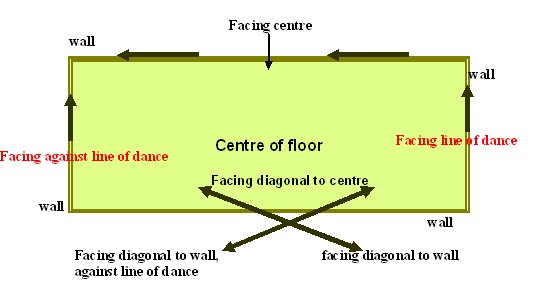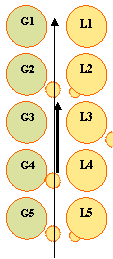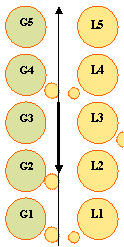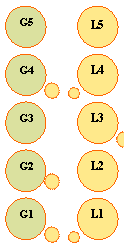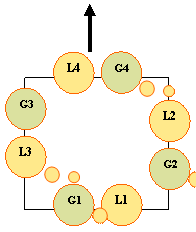Dance terms |
|||||||||||||||
|---|---|---|---|---|---|---|---|---|---|---|---|---|---|---|---|
It is necessary that everyone knows what they are supposed to be doing. The definitions detailed below should enable an understanding of the basics. Dance Formation (Where do we stand?) |
|||||||||||||||
Other dance instructions give the number of bars of music required for each part of the dance. I have used a different system, which counts out the steps of the dancer to each beat of the music. While this involves a high number of counts by the end of the longer dances, this can avoided by dividing each dance into sections of eight or sixteen counts. |
|||||||||||||||
Line of dance |
|||||||||||||||
Think of the line of dance as an imaginary line which travels round the ballroom, parallel to the walls. The dancers move in an anti-clockwise direction. So, when you ‘move against the line of dance', you go along this line in a clockwise direction. When you are instructed to ‘stand facing the line of dance' the ballroom wall should be on your right and the centre of the floor on your left. Diagonal to wall – facing midway between the line of dance and the wall Diagonal to centre – facing midway between line of dance and centre. Diagonal to wall, against the line of dance – facing midway between the wall and against the line of dance. Diagonal to centre, against line of dance – facing midway between the centre and against line of dance. A diagrammatical demonstration:
|
|||||||||||||||
Dance Formation (Where do we stand?) |
|||||||||||||||
|
|||||||||||||||
Dance positions (How do we hold our partners?) |
|||||||||||||||
Couples stand side by side, with the gent nearer the centre of the circle and the lady on the outside, usually facing anti-clockwise. They join hands in front of their bodies, left in left, right in right. |
%201.jpg) |
%202.jpg) |
|||||||||||||
Gent and lady face each other. The gent puts his right hand round the lady's waist. The lady puts her left hand on the gent's right shoulder. The lady puts her right hand into the gent's left hand, held slightly up and out to the left of his body. |
%203.jpg) |
%204.jpg) |
|||||||||||||
The lady stands on the gentleman's right side with her left hand in his right hand. Both partners face down the line of dance. |
%205.jpg) |
%206.jpg) |
|||||||||||||
The partners stand facing each other. The lady's left hand is in the gentleman's right hand and her right hand in his left. Their joined arms are raised to the side and extended. |
7.jpg) |
%208.jpg) |
|||||||||||||
The partners face down the line of dance with the gentleman standing slightly behind the lady and to her left. His left hand holds her left hand at shoulder level, and his right hand holds her right hand over her right shoulder. |
%209.jpg) |
%2010.jpg) |
|||||||||||||
Both partners face down the line of dance with the lady on the gentleman's right. He places his right arm around her waist. She puts her left hand on his right shoulder. |
%2011.jpg) |
%2012.jpg) |
|||||||||||||
The lady turns under the gentleman's and lady's joined hands (left hand to left hand joined, right hand to right hand joined and the joined right hands are on top). As the lady turns to her right or left the joined hands are raised in a bower position to allow the lady to turn under. |
%2013.jpg) |
%2014.jpg) |
|||||||||||||
|
|||||||||||||||
Moves (What do we do?) |
|||||||||||||||
Basket Two couples stand close to each other. Each lady puts their left arm round the neck of the gent on their left side and their right arm round the neck of the gent on their right. The gents put their arms round the ladies' waists. All four put their right foot slightly forwards and slip round clockwise. If the gents keep steady the ladies can swing on their shoulders and lift both feet off the ground. Cast off Dancing couple at top of longways set. They split, lady goes right, behind the row of ladies, and gent goes left, behind the row of gents. They are supposed to face away from the set and go the long way round. In other words, partners stand side-by-side, the lady on the gent's right. The lady turns to her right and dances down the line of dance on the outside of the set on her side. Gent turns to his left and dances down the outside of set on his side. Dos-a-Dos (Dosi-do) Gent and lady go towards each other, pass shoulders, go back behind each other then reverse back to their places. So, facing partner, walk forward with partners passing right shoulder to right shoulder. Step to the right behind partner. Walk backwards, with partners passing left shoulder to left shoulder, to return to original position. Figure of Eight Three dancers interweave in a figure-of-eight formation. Each dancer follows the shape of a number eight. If the set consist of lady, gent and lady, then gent and first lady pass left shoulders, then first and second ladies pass right shoulders. Gent and second lady then pass left shoulders, and then gent and first lady pass right shoulders. First and second ladies then pass left shoulders, and gent and second lady pass right shoulders. All are then back in original place. Left Hand Star Four dancers join left hands with their arms making a star shape and go round anti-clockwise. So, couples join their left hands above shoulder level and skip round to the left. Progression This is when the dancers change partners or move to a new group of dancers, either at the same time in the middle of a dance or after time through. Right Hand Star Four dancers join right hands with their arms making a star shape and go round clockwise. So, couples join their right hands above shoulder level and skip round to the right.
|
|||||||||||||||
Dance Steps (How do we move our feet?) |
|||||||||||||||
Advance and Retire Three steps forward and close. Three steps back and close. March A simple left-right marching step. Running Step Exactly what it says – running left-right, usually to fit in with the two main beats in jig time. Setting One step is three movements of the feet, on the spot, right, left, right, then left, right, left. Slip Step (Sideways) If to the left, then the left foot steps wide to the side, with the right foot closing towards it. In other words, step to the side on toes of left foot and close heel of right foot to heel of left foot. Step to the side on toes of right foot and close heel of left foot to heel of right foot. Continue in this manner. Waltz Round Fit three steps into each count, going left, right, left, or right, left, right. |
|||||||||||||||
